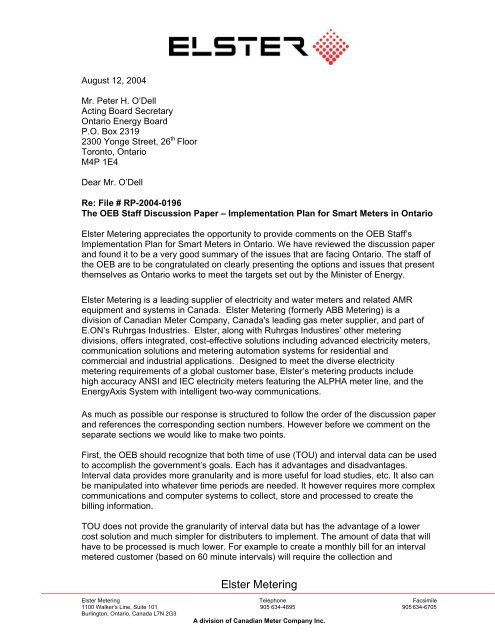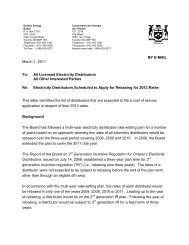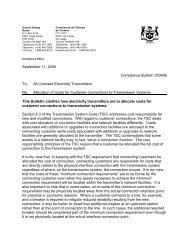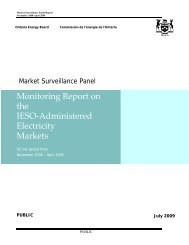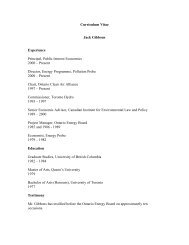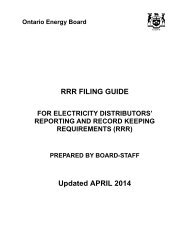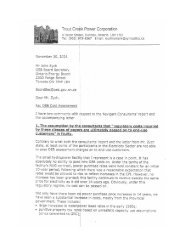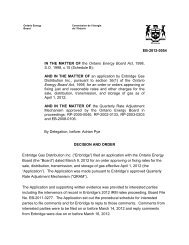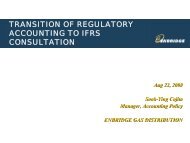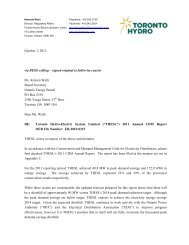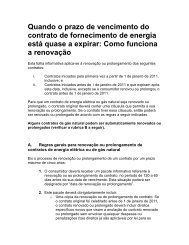Elster Metering - Ontario Energy Board
Elster Metering - Ontario Energy Board
Elster Metering - Ontario Energy Board
You also want an ePaper? Increase the reach of your titles
YUMPU automatically turns print PDFs into web optimized ePapers that Google loves.
August 12, 2004Mr. Peter H. O’DellActing <strong>Board</strong> Secretary<strong>Ontario</strong> <strong>Energy</strong> <strong>Board</strong>P.O. Box 23192300 Yonge Street, 26 th FloorToronto, <strong>Ontario</strong>M4P 1E4Dear Mr. O’DellRe: File # RP-2004-0196The OEB Staff Discussion Paper – Implementation Plan for Smart Meters in <strong>Ontario</strong><strong>Elster</strong> <strong>Metering</strong> appreciates the opportunity to provide comments on the OEB Staff’sImplementation Plan for Smart Meters in <strong>Ontario</strong>. We have reviewed the discussion paperand found it to be a very good summary of the issues that are facing <strong>Ontario</strong>. The staff ofthe OEB are to be congratulated on clearly presenting the options and issues that presentthemselves as <strong>Ontario</strong> works to meet the targets set out by the Minister of <strong>Energy</strong>.<strong>Elster</strong> <strong>Metering</strong> is a leading supplier of electricity and water meters and related AMRequipment and systems in Canada. <strong>Elster</strong> <strong>Metering</strong> (formerly ABB <strong>Metering</strong>) is adivision of Canadian Meter Company, Canada's leading gas meter supplier, and part ofE.ON’s Ruhrgas Industries. <strong>Elster</strong>, along with Ruhrgas Industires’ other meteringdivisions, offers integrated, cost-effective solutions including advanced electricity meters,communication solutions and metering automation systems for residential andcommercial and industrial applications. Designed to meet the diverse electricitymetering requirements of a global customer base, <strong>Elster</strong>’s metering products includehigh accuracy ANSI and IEC electricity meters featuring the ALPHA meter line, and the<strong>Energy</strong>Axis System with intelligent two-way communications.As much as possible our response is structured to follow the order of the discussion paperand references the corresponding section numbers. However before we comment on theseparate sections we would like to make two points.First, the OEB should recognize that both time of use (TOU) and interval data can be usedto accomplish the government’s goals. Each has it advantages and disadvantages.Interval data provides more granularity and is more useful for load studies, etc. It also canbe manipulated into whatever time periods are needed. It however requires more complexcommunications and computer systems to collect, store and processed to create thebilling information.TOU does not provide the granularity of interval data but has the advantage of a lowercost solution and much simpler for distributers to implement. The amount of data that willhave to be processed is much lower. For example to create a monthly bill for an intervalmetered customer (based on 60 minute intervals) will require the collection and<strong>Elster</strong> <strong>Metering</strong><strong>Elster</strong> <strong>Metering</strong> Telephone Facsimile1100 Walker’s Line, Suite 101 905 634-4895 905 634-6705Burlington, <strong>Ontario</strong>, Canada L7N 2G3A division of Canadian Meter Company Inc.
- 2 -processing of 720 pieces of data. For a TOU customer (assuming 2 time periods and atotal) 3 pieces of data will have to be read and processed.Secondly <strong>Elster</strong> believes that the definition of a Smart Meter should be expanded tospecify that the meter not only be capable of “reporting usage according to predeterminedtime criteria” but that it also be capable of storing that data in internal registers orrecorders. This ability is necessary to minimize the risk of lost data. It also then defines aSmart Meter as opposed to a Smart System.Section Comments2 Background – Price responseThe definition of what a price signal is should be clarified. Our suggestion is: “A pricesignal is a message sent to customers in the form of a price charged for a commodity withthe intent to produce a particular result.”Definition of a Smart MeterThe definition of a Smart Meter should be expanded to include the capability of storingTOU and/or interval data. Smart meters measure, record and store energy consumption.They also dispaly same usage values on the meters that it reports up to an AMR System.2.2.1 – Benefits to CustomersThe collecting of energy usage as interval data is the only way to ensure that customerspay the actual price for the electricity at the time that they use it. TOU will require somekind of “true-up” between the price charged for the particular time period and the averageHOEB for the period.In the third paragraph of this section it states that “When individual use is intervalmetered, a consumer...” <strong>Elster</strong> notes that TOU can accomplish the same goal and shouldbe included in the statement.2.2.2 – Benefits for the System and the MarketThere are additional benefits when the system peak is lowered. Much of the generationthat is used to supply peak requirements is coal fired. Lowering the peak demand thenlowers the pollution caused by generation. Other benifits include:• Lower energy prices• Lower operating costs• Fewer system failures2.2.4 – Benefits for RetailersRetailers will also have the opportunity to provide value added services. These couldassist consumers in reducing and shifting their consumption and might include:• Posting usage patterns on the internet• Providing consulting services aimed at assisting consumers in reducing theirdemand<strong>Elster</strong> <strong>Metering</strong><strong>Elster</strong> <strong>Metering</strong> Telephone: Facsimile1100 Walker’s Line, Suite 101 905 634-4895 905 634-6705Burlington, <strong>Ontario</strong>, Canada L7N 2G3A division of Canadian Meter Company Inc.
- 3 -There may also be opportunities for meter services providers to own and operate AMRsystems for utilities. This may be of particular benefit for small utilities that may not havethe resources to operate their own systems.2.2.5 – Benefits to DistributorsThis section appears to assume that the introduction of Smart Meters will necessitate theintroduction of Automatic Meter Reading systems. <strong>Elster</strong> agrees with this assumption. Theincreased amount of metering data can only be efficiently collected through an AMRsystem.Depending on what AMR system a distributor chooses they may realize benefits that gobeyond those listed. These could include:• Fewer meter reading errors• Fewer missed reads, requiring additional site visits or estimated bills• On demand reads for move in/out• No site visits implement new TOU rates• <strong>Energy</strong> diversion and tamper detection3.1 – Procurement Strategy<strong>Elster</strong> has no objections to a comprehensive procurement strategy. However, based onour experience with existing buying groups in <strong>Ontario</strong> we note that there may be limitedbenefits for distributors.In order for suppliers to offer volume discounts there has to be conformity of requirements.Our experience has shown that each distibutor has different programming requirementsfor their meters, particularly commercial and industrial meters. The need for distributors tonegotiate common specifications may be difficult.Should the OEB decide to implement aomprehensive procurement strategy, <strong>Elster</strong>believes that it should be optional for distributors to participate. This will not preventdistributors from choosing the meters and AMR systems that best meet their needs.3.2.2 – New HomesAs noted earlier the introduction of smart meters will likely make it necessary for utilities toalso purchase new AMR systems. As stated in section 2.2.5 the introduction of theseAMR systems will also give the distributors benefits beyond just meter reading.In order for distributors to realize these benefits they will have to devlop strategies for theintroduction of the AMR system in their service territories. Typically this is done by massdeployment of meters in whole sections of the service territory. The requirement for smartmeters in all new homes and businesses may hinder a distributor’s ability to carry out theirstrategy.If the new home is located in an existing neighbourhood that the distributor has not yetscheduled for deployment of the AMR system, the distributor should not be mandated to<strong>Elster</strong> <strong>Metering</strong><strong>Elster</strong> <strong>Metering</strong> Telephone: Facsimile1100 Walker’s Line, Suite 101 905 634-4895 905 634-6705Burlington, <strong>Ontario</strong>, Canada L7N 2G3A division of Canadian Meter Company Inc.
- 4 -put a smart meter on that site until the AMR system is deployed in that area. It is likely thata meter removed from an area where the system is being deployed could be used for thenew home, preventing the creation of a new stranded asset.If the OEB decides to require smart meters on new installations it should liimit thatrequirement to areas (e.g. large new subdivisions) where the installation of a smart meterwill not hinder a distributor in carrying out their AMR strategy.3.2.4 – Self-selection<strong>Elster</strong> has experience with self-selection program through our involvement with our watermeter customers. Many cities, when introducing water meter programs have allowed theirresidents to request a water meter be installed in their home before their neighbourhood istargeted for mass deployment. These programs have typically had very low enrolmentfigures and have made it more difficult and costly to implement an overall deploymentstrategy.As noted in our comments to 3.2.2 the need to install smart at request may also make itdifficult for a distributor to implement a AMR deployment strategy. This may negativelyaffect the distributor’s ability to realize the operational benefits outlined in 2.2.5.4 – Cost RecoveryIn the cost categories list, “Meter” should be “Meter material cost”. This will differentiatethe meter hardware costs from an additional cost not listed. That is the cost of integratingnew AMR systems into a distributors business system. That could be a significant cost fordistibutors and should be added to the list of cost categories.In the 2nd paragraph the second sentence should be changed to ' time differentiatedmeter data'. There should not be an underlying assumption it will be interval data. It couldbe TOU data.In the 3rd paragraph, while current policy under DSC is focused on commercial andindustiral metering, cost recovery shouldn't assume interval meters. The paragraph shouldbe reworded to be broader than just interval meters.5 – <strong>Metering</strong> FunctionsThe definition of a Smart Meter should include at a minimum the ability to measure,record, store and report usage according to predetermined time criteria. Additionalfunctionality should be market dirven.<strong>Elster</strong> <strong>Metering</strong><strong>Elster</strong> <strong>Metering</strong> Telephone: Facsimile1100 Walker’s Line, Suite 101 905 634-4895 905 634-6705Burlington, <strong>Ontario</strong>, Canada L7N 2G3A division of Canadian Meter Company Inc.
- 5 -5.2 - ReportingThe Minister’s directive “requires that a smart meter be adaptable or suitable, withoutremoval of the meter, for seasonal and time of use commodity rates, critical peak pricingand other foreseeable electricity rate structures.”TOU meters can be used to meet this requirement. The newest generations of TOUmeters that are available can record energy consumption in different registers for specifictime periods but also allow for a critical tier over-ride that allows the retailer or distributioncompany to signal when a critical peak time will occur. The meter would then accumulateusage in a separate critical tier register. These meters and systems allow for CPP anddynamic TOU where tiers could be changed as needed. TOU meters also have the abilityto display the energy consumed during each specific time period. Interval meters do nothave that capability.TOU also has the advantage of being more easily understood by residential consumers.When consumption is divided into large time periods, and the time based usage is clearlyprinted on bills, consumers will find their bills more meaningful.5.3 – Data StorageThe OEB correctly indicates that one of the issues will be the amount of data that will haveto be collected, validated, edited and stored with interval meters.Using TOU meters for residential consumers instead would greatly reduce the amount ofdata storage reguirements. In addition, reading the TOU data directly from the meterregisters reduces the amount of validation that is required. If a TOU meter is programmedwith three bins (time periods) and an additional critical peak bin and billing is done on amonthly basis, 48 data sets would need to be collected and stored per consumer.5.4 – Bi-directional CommunicationFor distributors to realize most of the benefits of an AMR system as detailed in 2.2.5, bidirectionalcommunication is necessary. This will help offset the costs of the systems. Bidirectionalcomunications are necessary for a distributor to change the TOU switch times,implement CPP and send price signals to the meter. However the bi-directionalcommunications should be transparent. The communications network should not performmetrology function but rather be a pipe for sending data.6 – OwnershipThe OEB should be carefull if they allow contestability of meter provision. As noted earlierthe introduction of smart meters will likely make it necessary for utilities to also purchasenew AMR systems to collect the increased amount of data. These systems require allmeters within the coverage area to be compatible with the system to be cost effective. Ifindividual consumers are given the right to purchase their own meters from independentsuppliers mechanism should be put in place to ensure that the meter’s type and functionmeets the conmpatibility requirements of the system. Otherwise operational benefits willbe lost leading to increased costs to the distributor.<strong>Elster</strong> <strong>Metering</strong><strong>Elster</strong> <strong>Metering</strong> Telephone: Facsimile1100 Walker’s Line, Suite 101 905 634-4895 905 634-6705Burlington, <strong>Ontario</strong>, Canada L7N 2G3A division of Canadian Meter Company Inc.
- 6 -The providing of meter services should be contestible. For example third parties couldhost AMR software and provide meter reading services to distributors.7 – Measurement Canada ConsiderationsFor some time now Measurement Canada has been reviewing its policy on time of useand interval metering. Recently they issued Bulletin GEN-31, their policy on MultirateRegister <strong>Metering</strong>. This policy does not place any limits on the use of multirate register(TOU) meters or the use of interval meters used in multrate metering applications. Itclearly acknowledges that the “setting and application of billing rate conditions” is aprovincial matter and outside the jurisdiction of Measurement Canada.7.2 – Production and InstallationThere is adequate manufacturing capacity that manufacturers will be able to supply thevolumes of meters given in Table 1.<strong>Elster</strong> <strong>Metering</strong> would be happy to meet with OEB staff to discuss and clarify ourcomments. We welcome the oppurtunity to continue our involvment in the process ofdevelopment of an implentation plan for smart meters in <strong>Ontario</strong>.Yours truly,Clarence BatterinkProduct Manager<strong>Elster</strong> <strong>Metering</strong>Email: clarence.e.batterink@ca.elster.comPhone: 905-634-4895Fax: 905-634-6705Jack RobertsonVice President and General Manager<strong>Elster</strong> <strong>Metering</strong>Email: jack.d.robertson@ca.elster.com<strong>Elster</strong> <strong>Metering</strong><strong>Elster</strong> <strong>Metering</strong> Telephone: Facsimile1100 Walker’s Line, Suite 101 905 634-4895 905 634-6705Burlington, <strong>Ontario</strong>, Canada L7N 2G3A division of Canadian Meter Company Inc.


